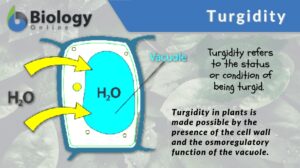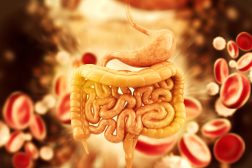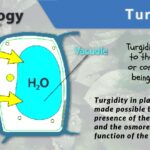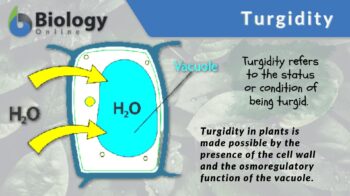
Turgidity
n., plural: turgidities
[tɜːˈdʒɪdɪtɪ]
Definition: The state or condition of being turgid
Table of Contents
Turgidity Definition
Turgidity is the state of being turgid or swollen, especially due to high fluid content. In a general context, turgidity refers to the condition of being bloated, distended, or swollen. In a biological context, turgidity helps to explain how plant cells are able to stand upright despite the lack of a skeletal structural framework that animals have. Also, it confers rigidity to plants. Thus, the distention of cells is a normal feature among plants. In fact, without it, the plant will look wilted and unwell. Turgidity in plants is made possible by the presence of the cell wall and the osmoregulatory function of the vacuole. The cell wall protects the cell from cell lysis due to high water influx while the vacuole regulates solute concentration to incite the osmotic movement of water into and out of the cell.
Etymology: The term turgidity comes from the Latin turgidus, from turgēre, meaning “to be swollen”.
Plant Turgidity
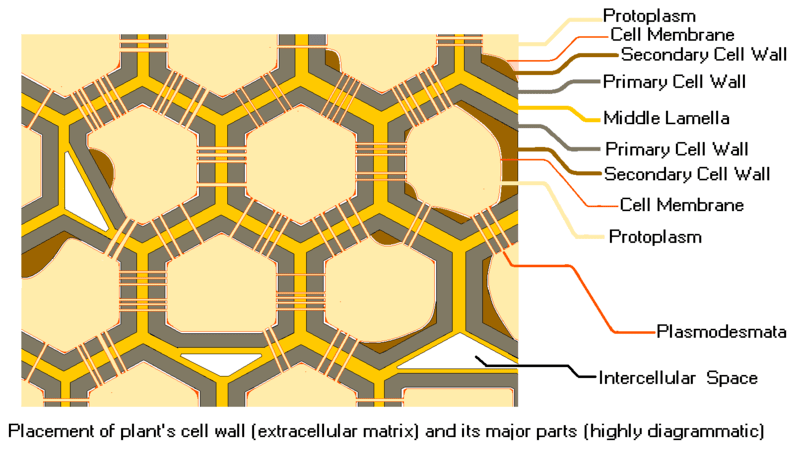
Plant turgidity is a condition in plants wherein the cells are turgid due to turgor pressure, i.e. the pressure that is being exerted by water inside the cell against the cell wall. One of the important features of a plant organism is its cell wall.
A cell wall is another layer surrounding a cell.1, 2 The animals lack them and only have a cell membrane. Plants have both. The cell wall is an additional protective layer in the cells of the plant. It is a tough, rigid structure made up chiefly of cellulose, pectin, and hemicellulose. The cell wall of plants is comprised of one or two layers. The first layer is called the primary cell wall. This layer could produce another layer just beneath it. The new layer is called the secondary cell wall. The second layer is a thick layer that deposits lignin. The lignin helps waterproof the cell. These features of the cell wall help the plant cell to resist osmotic pressure, i.e. the hydrostatic pressure produced by a difference in the amounts of solutes between solutions separated by a semipermeable membrane, such as the cell membrane, during osmosis.3, 4, 5
Turgidity, Flaccidity, And Plasmolysis
What is a turgid cell? How to tell if a cell is flaccid or plasmolyzed? Let’s find out.
Turgid cell
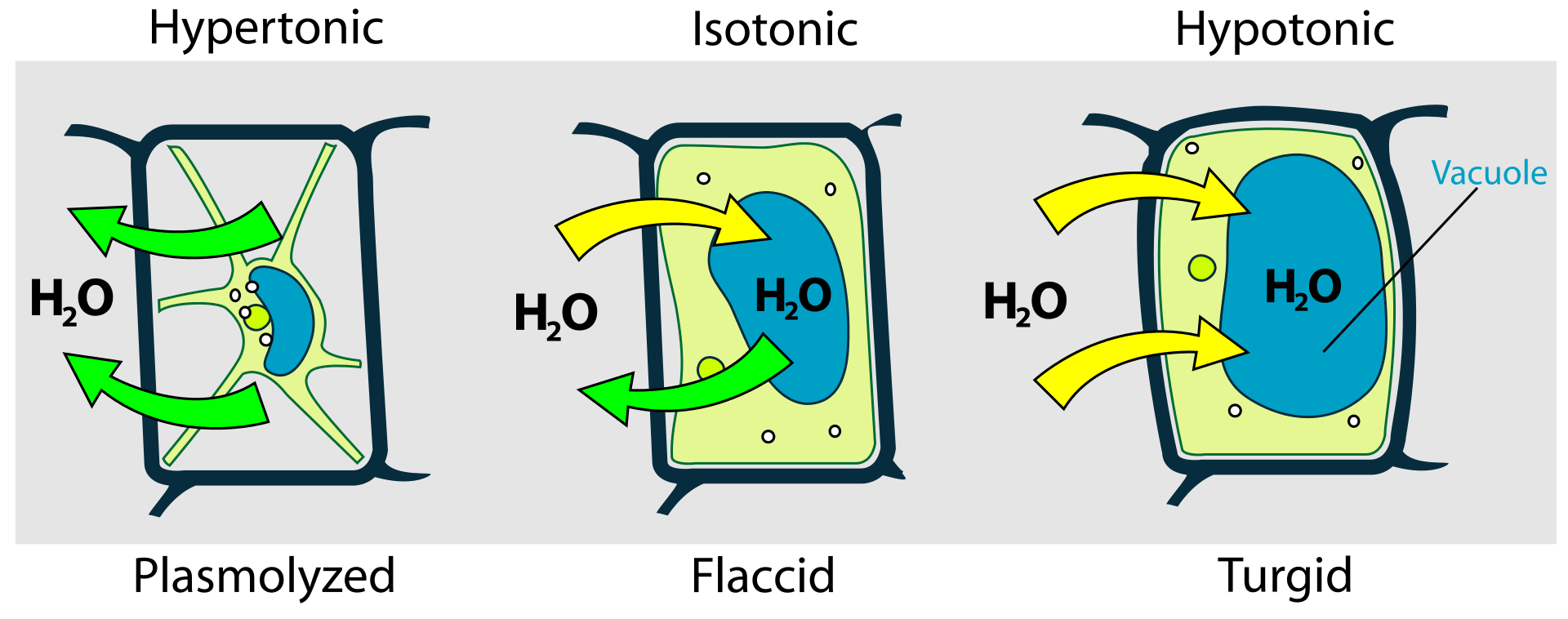
The plant that looks healthy (i.e. not wilted) has cells that are turgid. The plant cell stores solutes (e.g. ions and sugars) (particularly, inside its vacuole). Since the inside of the cell has a higher solute concentration (and therefore fewer water molecules) than the outside, the water tends to move in. The solution (surrounding the cell) that has a lower solute concentration relative to what was inside the cell is described as hypotonic.
A plant cell that is placed in a hypotonic solution would cause the water to move into the cell by osmosis. The resulting influx of water leads to a large turgor pressure being exerted against the plant cell wall. This makes the cell turgid.
The presence of the cell wall in plants prevents the cell from bursting (osmotic lysis), which happens in a cell lacking a cell wall. An animal cell, for instance, would swell in a hypotonic solution. However, if osmosis persists, it will eventually burst. Thus, the cell wall of the plant cell is essential to stabilize the cell integrity and prevent the cell from bursting.
Excessive osmosis in a plant cell is prevented due to the osmotic pressure being exerted by the cell wall. However, the cell wall cannot protect the plant cell that has been exposed to an isotonic solution or a hypertonic solution. These solutions can cause the plant to lose its vigor and appears wilted.
Flaccid cell
An isotonic solution refers to a solution wherein the solute concentration is relatively the same as the solute concentration inside the cell. This means that there would be no net movement of water molecules between the two. A plant cell that is placed in an isotonic solution would become flaccid. This condition is called flaccidity. A flaccid plant cell is not swollen and its cell membrane does not press against the cell wall tightly. Thus, the difference between turgidity and flaccidity lies in the turgor pressure. In turgidity, a plant cell appears swollen or distended from the turgor pressure put on the cell wall whereas in flaccidity the plant cell loses it and appears limp or flaccid.
Plasmolysed cell
A hypotonic solution is a solution wherein the solute concentration is higher than the solute concentration inside the cell. A plant cell in a hypotonic solution loses its turgor pressure as the water molecules tend to move out of the cell. The cell that has lost its turgor pressure is described as plasmolyzed. A plasmolyzed plant cell is one in which there are gaps between the cell wall and the cell membrane. Furthermore, the cell appeared to have shrunk. The process or the condition in which the protoplasm shrinks as a result of water loss by osmosis is called plasmolysis. However, plasmolysis rarely occurs in nature. Rather, it is induced in the laboratory where plant cells are immersed in strong saline or sugar solutions.
Watch this vid about the different types of solutions and osmosis:
Turgidity and Rigidity
As cited above regarding the turgidity meaning, turgidity refers to the state of being turgid or swollen as the result of the fluid contained. Rigidity, in contrast, pertains to the state of being rigid or stiff and unbending. Both turgidity and rigidity are important features of plants as they keep the plant to stay upright. And both of these features can be attributed to the turgor pressure up against the cell wall. As explained above, the cell wall strengthens and prevents the cell from osmotic pressure that in excess could bring about osmotic lysis to cells without it.
The cell wall also provides structural support by forming a thicker secondary layer containing lignin. Apart from that, the cell wall contains cellulose that renders it to become rigid and tough. In between the cell wall is another layer of pectin-rich intercellular material. This layer is called the middle lamella. Its primary function is to glue the adjacent cells together. All in all, these cellular features of the plant enable it to stay upright towards the source of light, against the gravitational pull.
Importance of Turgidity in Plants
Turgidity is essential to plants as it provides structural support and strength. Without it, the plant would not be able to keep upright – a stance wherein the collection of light energy for photosynthesis is at best. Besides this, it also confers rigidity to plants. When there is not enough water absorbed to produce turgor the plant cells will not be fully distended. The persistence of this condition will lead to the plant appearing wilted and unwell. The drooping due to loss of turgor can be corrected, e.g. with adequate water to process by the vacuole through osmoregulation.
Answer the quiz below to check what you have learned so far about turgidity.
Further Reading
- To learn more about plant cells, view Plant Biology
References
- Plant Cell Wall Basics. (2019). Retrieved from Uga.edu website: Link
- FIGURE 1 Structure and composition of the primary and secondary cell wall. (2017, October 31). Retrieved from ResearchGate website: https://www.researchgate.net/figure/Structure-and-composition-of-the-primary-and-secondary-cell-wall-of-plants-A-The_fig5_320734221
- OSMOSIS. (2013). Retrieved from Byui.edu website: Link
- Osmosis, Tonicity, and Hydrostatic Pressure. (2019). Retrieved from Colostate.edu website: Link
- Lodish, H., Berk, A., S Lawrence Zipursky, Matsudaira, P., Baltimore, D., & Darnell, J. (2017). Osmosis, Water Channels, and the Regulation of Cell Volume. Retrieved from Nih.gov website: Link
© Biology Online. Content provided and moderated by Biology Online Editors

